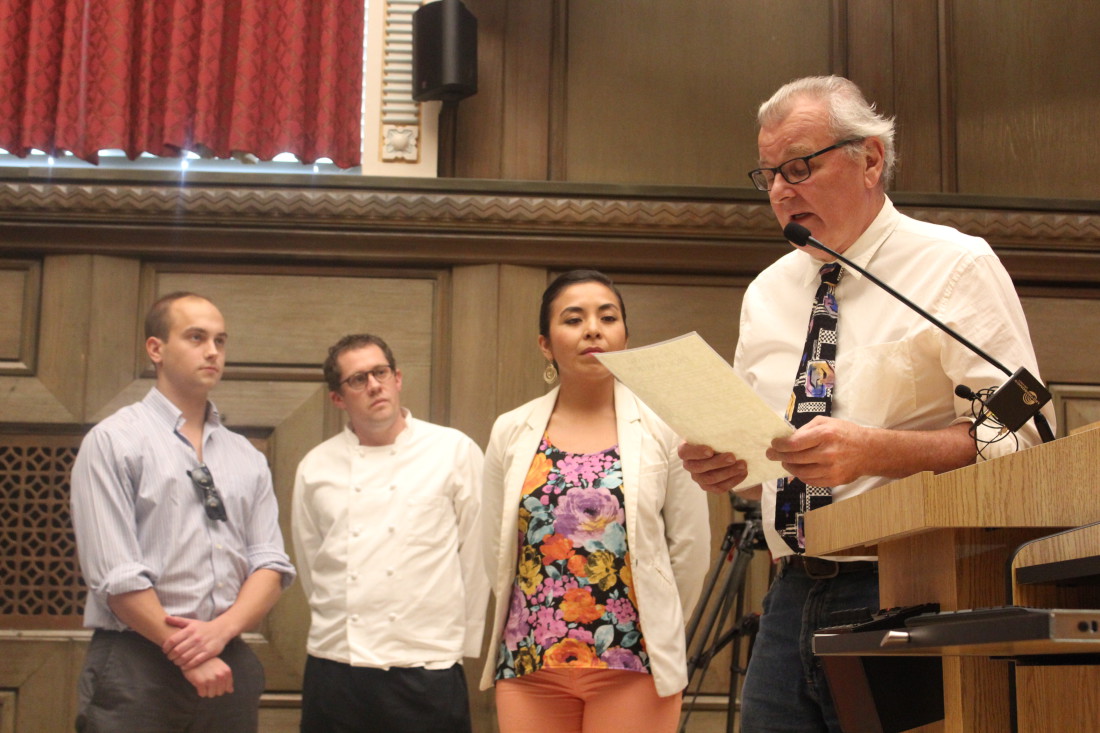“Anytime I’ve come to City Council,” said Dawn Nelson, who identified herself as a resident of Asheville’s East End, “there seems to be this wonderful service-oriented aspect of the Council itself that wants Asheville to be the unique and wonderful thing Asheville can be. And then there are these wonderful citizens who are doing all kinds of crazy and wonderful things. And then there’s staff. And that seems to be a very dark and impenetrable place to get to. Things seem to disappear in a welter of process and Powerpoint and best practices.”
City staff were on the hot seat at Council’s regular meeting on Oct. 25, as communication failures that led to the destruction of several fruit trees at George Washington Carver Edible Park last month received a public airing.
Parks & Recreation Department Director Roderick Simmons apologized for the error and described new practices in the works to prevent similar incidents in the future. Those practices include adhering to existing city communication processes and implementing a new system to provide notification of planned tree and vegetation cutting by any city department. Notification would take the form of signage similar to the signs posted by the city’s Planning and Zoning Commission to announce upcoming public hearings; the notices would be posted two to three months in advance of the planned tree cutting, Simmons said.
But representatives from organizations that work closely with the city on food policy, sustainability and economic issues weren’t ready to let the matter go without expressing their frustration.
The incident at George Washington Carver Park, in which fruit trees were cut to address safety and lighting concerns brought forward by a park neighbor, occurred just a few months after a similar incident at the Montford Recreation Center, Darcel Eddins pointed out. “A lot of people have put a lot of their volunteer hours into this and they feel dismissed by the city,” said Eddins, who is executive director of Bountiful Cities, which founded George Washington Carver Edible Park in 2002. The park was the first of its kind in the nation, she said, and the city’s actions in destroying mature plantings there without notifying her organization and others “created a lot of conflict and a lot of tension within the city and in the community.”
Nicole Hinebaugh, who is involved with Bountiful Cities, the Urban Agriculture Alliance and the Asheville-Buncombe Food Policy Council, expressed disappointment that the city’s sustainability director, Amber Weaver, had not been informed about the city’s decision to cut trees in the park. “All of this could easily have been prevented by walking across the hall, or by an email or a phone call,” she said.
Referring to the experiences of the social and economic justice advocacy organization Just Economics, Vicki Meath said the problems with responsiveness and communication extend beyond the Parks & Recreation department. “We have had many experiences communicating with [city] staff. The vast majority of the time it’s been us constantly pressing and constantly following up. You never come to us. You know we’re there,” she said.
Calling the misstep “a poor piece of communication” that revealed “some performance issues in the way it was carried out,” City Manager Gary Jackson said the incident was a learning opportunity for the city. “We have higher expectations,” he concluded.
“None of the individual steps is difficult,” commented Council member Julie Mayfield. “I would encourage the city not to get too hidebound in the process of this, in documenting communications plans for everything. It’s not difficult, there just needs to be a core commitment to making sure that the right people are at the table when the decisions get made. And … I hope that is every public servant’s instinct, and I have confidence that what you are doing is going to get us there, and I would ask the folks who are here today and watching to continue to hold us accountable for this.”
Mayor Esther Manheimer said City Council wanted to show the community that the issue is being addressed internally through a public discussion at the Council meeting.
Consent agenda
Prior to voting on its consent agenda, Council agreed to move the proposed public hearing for land use incentive grants to support affordable housing development at Skyland Exchange on Miami Circle in South Asheville from Nov. 8 to Dec. 13. Manheimer said she had been made aware of concerns that turnout for the hearing might be impeded if it were held on the same evening as the General Election.
With the exception of a resolution to make Nov. 8 a fare-free day for the city’s public transit system, Council passed its consent agenda unanimously.
The item regarding transit fares for election day was discussed separately. Vice Mayor Gwen Wisler pointed out that Council had approved a fare-free day for the primary elections in March. Overall ridership on that day was actually lower than usual, she said, and an attempt to evaluate the effectiveness of eliminating the fare as a means of increasing voter turnout had been inconclusive. Wisler recommended limiting the fare-free day to transportation services for citizens with disabilities. Mayfield said the Transit Committee of the city’s Multimodal Transportation Commission had voted to approve the fare-free day.
Council voted to approve the fare-free day 6-1, with Wisler opposed.
Haywood and Page Advisory Team
Chris Joyell presented an update on the public input gathering activities undertaken by the Haywood Street Advisory Team. The team is charged with developing a community vision for the use of city-owned properties facing the Basilica of St. Lawrence and the U.S. Cellular Center.
Of over 1,000 public comments received, Joyell said, uses from “a grassy park to a parking deck and everything in between” had been suggested. He said the advisory team is working with a graduate class at Lenoir-Rhyne University to generate visual tools that will represent the themes that have emerged from public comments. The advisory team also anticipates presenting a bubble diagram showing the preferred uses for the site and their relationship to one another.
Andrew Fletcher, who was recently named chair of the advisory team, presented a long list of options for temporary uses of the site, which included both amenities and activities. The selected temporary uses, he said, should be “light and cheap” to implement. Fletcher asked Council to indicate some preferences for temporary uses, but Manheimer responded that the point of establishing the advisory team was to determine a direction for the properties’ use. “Our job will be to determine whether we can achieve it, staff it and afford it. We want to know what your group would say is preferred as a temporary use,” she explained.
“I appreciate that you guys are struggling with consensus, struggling with process,” Manheimer said. “We did the same thing for a long time.” Nonetheless, the mayor asked the group to come back with a shorter list of recommendations. “If you need less options, we can bring those,” Fletcher responded. “Many less,” said the mayor.
Affordable housing grant
Council unanimously approved a land use incentive grant for a proposed affordable housing development on Simpson Street. The grant will provide an estimated total of $373,710 in property tax relief and rebates of city development fees, which is equivalent to a per-unit subsidy of less than $10,000. Jeff Staudinger, Assistant Director of Community and Economic Development, said the city has historically given $15,000-$20,000 per unit in subsidies to other affordable housing projects, making the 70-unit Beaucatcher Commons project an especially cost-effective development.
The project also has received loan funding from the city’s Affordable Housing Trust Fund.
Signage plan application process amendment
Council approved a wording amendment related to signage designed to bring the city’s zoning code into alignment with recent state and federal court decisions. Prior to Council’s approval of the amendment, two pathways for seeking a variance from the city’s signage ordinance existed: an appeal to the Board of Adjustment or submission of an alternative signage plan to City Council. The change eliminates the second alternative. All variance requests will now be heard by the Board of Adjustment. Applicants must demonstrate that the signage ordinance imposes a hardship, and the request must be heard through a quasi-judicial process that will be decided on the basis of pre-determined standards.
In response to a question by Council member Cecil Bothwell, City Attorney Robin Currin explained that the Ingles Markets alternative signage package recently heard by Council would, under the wording amendment, now come before the Board of Adjustment. No signage variances will be heard by City Council in the future, she said, unless Council opts to change additional aspects of the signage ordinance. According to the recent court decisions, she said, “Any time there is discretion [in applying signage standards], you have to have a quasi-judicial process that adheres to standards.”
Council passed the amendment 6-1, with Council member Brian Haynes opposed.
Downtown public space management changes
The city has been working with street performers for several years on possible changes to the Downtown Public Space Management Plan, Assistant City Manager Paul Fetherston told Council. Proposed changes have been aimed at reducing overcrowding in popular areas and eliminating the need for pedestrians to walk in the street when crowds fill sidewalks around performances. Last month, he continued, the Public Safety Committee recommended designating two high-impact performance areas in front of Woolworth Walk on Haywood Street and the Flat Iron at Battery Park Avenue and Wall Street.
The changes will establish a 120-foot zone around the high-impact areas. Within the zones, no other audible performances will be allowed. Inaudible performances — such as living statues or tarot card readers — may take place a minimum of 40 feet from the high-impact areas, which is the spacing performers must observe in other areas of downtown. A six-foot passageway must also be maintained for sidewalk traffic.

Representing the Asheville Buskers’ Collective, musician Andrew Fletcher praised the plan and thanked the city for working with its buskers to come up with reasonable space management practices. The busking culture, he said, impacts the city’s entire music economy, but there aren’t many precedents for successfully managing busking in other cities.
After the meeting, local busker and advocate Abby Roach said she was glad the new plan represents an incremental change for Asheville’s street culture. Making too many changes too quickly, she said, would run the risk of shutting down or irreparably altering Asheville’s busking scene. This year, she continued, Asheville has seen fewer performers on the streets than in the past, a trend she chalks up to the high and rising cost of living in the city.
Council member Gordon Smith commented, “Through partnerships with downtown artists, the city has been better able to identify how to make the whole civic space be more productive and flow better, as well as being safer for everybody. So it’s this marriage of design and art and culture and safety and commerce.” Council approved the changes unanimously.
The meeting adjourned at 7:19 p.m. City Council’s next meeting will be on Tuesday, Nov. 8 at 5 p.m. in Council chambers on the second floor of Asheville City Hall.




Fare-free day. *Cringe*. That’s right, folks, get ready for your bus to be so full of homeless and drunks on that day that you can’t actually get on YOUR bus to get to your DOCTOR or your WORK when you need to.
God forbid, that we actually make a “reduced fare” day.
Yes, understandable…I am reporting city staff tomorrow for failure to address questions and needed actions! I am not
afraid to call for firings of city staff when necessary…it wakes em up downtown …